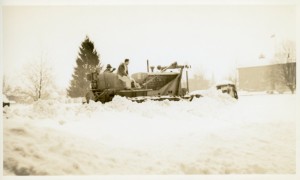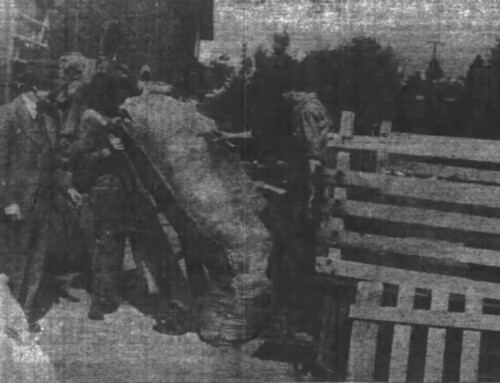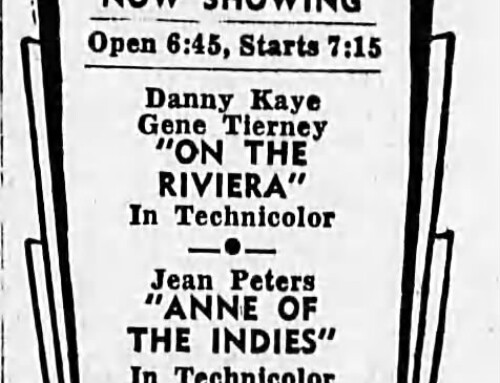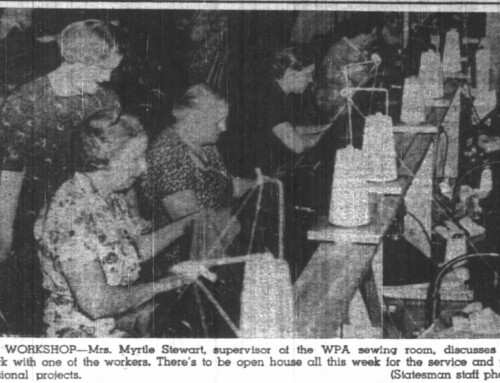The “Big Snow” hit Salem 80 years ago
This past week we marked the 80th anniversary of Salem’s record-setting single snow fall day. From 5:40 AM Sunday Morning January 31, 1937 through
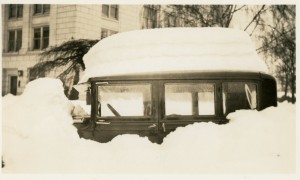
Car completely blocked in by the heavy snows on January 31, 1937 in Salem. Photo Source: Willamette Heritage Center, 1989.057.0005.
midnight of February 1, 1937 a blizzard dumped 24 inches snow on the city.[1] The surprise storm paralyzed the Salem (and most of the state) and led to much of the same conversations we have been having this winter about how much we should prepare for snow events that occur so infrequently in our neck of the woods.
The storm came as a bit of a surprise. Weather reports published in the Salem papers in the days leading up to it seemed mild enough. The Capital Journal’s report on Saturday anticipated the weather would be “Unsettled with occasional snows tonight and Sunday. Not so cold tonight.” The Oregon Statesman’s Sunday morning forecast was “Cloudy, probably rain or snow today and Monday” and called for .02 inches of rain with a north wind.[2] Actual events were much more dramatic. “Yes, This is Salem” a Capital Journal headline confirmed over a column of photographs featuring amorphous mounds of white obstructing views of downtown Salem streets and landmarks. Drifts as high as 32” were reported.[3]
Conditions were so bad that the city started hiring temporary workers to go out and hand shovel snow off walkways and out of streets. The Capital Journal claimed that the “city street department payroll was increased to larger proportions than for years” and City Engineer Hugh Rogers, when pressed, couldn’t give a clear count of the number of workers that were planning on working into the night. [4] Later counts
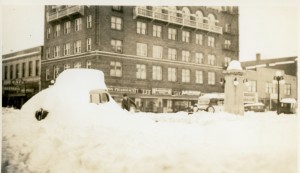
Man shovels out car on State Street after the big snow of 1937. Franklin Building/Masonic Temple can be seen in the background. Photo Source: Willamette Heritage Center, 1986.057.0007.
estimated a crew of 72 men in addition to the regular number of employees.[5] The hand shoveling supplemented the one bull dozer the city had at work. Because of the volume of snow, the removal plan included shoveling the snow into trucks and then “dumping it into the river” – presumably the Willamette.[6] Many people were reported as improvising snow plows to help out in their community. A man named Weathers in Keizer is said to have “constructed a V-shaped plow from 2×12 boards with which he opened the road west of the Keizer school and gave a clear one-way track for automobiles.”[7] Horses and Caterpiller tractors were also conscripted into plow and delivery services. [8] Despite the massive efforts, the phone at the County Courthouse continually rang with requests for service. “’We’ll get to you as soon as we can,’ is about the only answer available for these queries.” [9]
Effects of the Storm
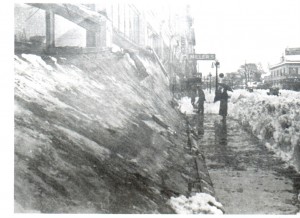
View of snow piled up on street and the collapsed awning at Miller’s Department Store (in the Reed Opera House) after the heavy snowfall on January 31, 1937. Photo Source: Willamette Heritage Center, Al Jones Collection, 1999.003.0001
Two feet of wet, heavy snow wreaked a lot of damage on buildings, too. Many structures collapsed under the weight. The large marquee overhang around Miller’s Department store (which operated in the Reed Opera House) collapsed under the weight of the snow, luckily early enough in the morning that nobody was underneath it at the time.[10] An eyewitness account of the collapse of the Evangelistic Tabernacle of God at 1288 Ferry Street (located where the state-owned parking structure now stands) demonstrates the strength of the piled snow. “Hearing a cracking sound, Mrs. C.M. Charlton, said she ran downstairs and onto the front porch in the belief that the apartment structure was giving away. She was just in time to see the tabernacle roof double in the middle and crash into the benches below, curling the front wall into the street, the west side wall into the alley and pushing the eastwall out to a precarious angle. The benches were converted to match wood.”[11] When the Dreamland skating rink collapsed, witnesses stated that the force sent shingles hurling across the street. [12]
City schools were closed for two solid days. When they re-opened on Wednesday motorists were warned to “use a little courtesy in their driving and slow down while passing children who, in many instances, will be compelled to take to the middle of the streets” in order to get to school. School superintendent Silas Gaiser suggested that parents keep their student’s feet dry by making sure they wore “rubbers or other waterproof footwear.”[13] While schools did open on Wednesday, the paper also predicted that the 600 students who were bussed from rural areas into Salem schools would probably get a few more days of vacation.[14]
There were other far reaching effects of the storm. In a time when milk was delivered daily to retailers and to individual homes, the daily papers put out ominous reports of impending milk shortages.[15] County owned snow plows priorities were to clear “milk routes, getting to people in distress, opening the way for feed to starving livestock, and opening roads for doctors to sick patients,” listed in that order.[16]
While most of the newspaper coverage describes the ways in which Salemites were “disenjoying” the weather, it didn’t stop everybody. Robert “Bob” Starr, a 17-year-old paperboy for the Capital Journal completed his 12-mile route to deliver 62 papers to his customers at the height of the snow. He did admit that he had to use his skis to do it.[17]
Storm Humor
In his “Sips for Supper” column for the Capital Journal newspaper on February 4, 1937, columnist Don Upjohn offered the following humorous observations about the snow storm in and around Salem:
Two handsome matrons were watching the big shovel hist [sic] snow from the streets near Miller’s corner the other day and dump it into trucks.
“What are they putting the snow in those trucks for?” Asked one.
“O, they haul it away and burn it,” responded the other.
We’ve noticed several schools of thought on snow removal have grown up out of the late great snowstorm. Some heartily approve everything the city has done. Some are certain the bulldozers should have removed the snow next to the curb and shoveled it into the middle of the street. Instead of shoving it from the middle of the street to the curb. Others are confident that the entire work of clearing the streets should have been done with man power and shovels. Another very vehement school of thought expresses the view that individual truck owners should have been called in instead of hiring the trucks in the main from one concern. But in the main the snow is off the main streets so traffic can go on- so what?
Speaking of the big snows which come in an average of about once in 20 years, a group of loyal friends of Jimmy Nicholson are getting together to form a fund for buying mothballs for Jimmy so he can store away in a safe place the equipment he bought for supervising the big snow fight from his vantage point in front of the First National bank building. It is the idea of the Association to Save the Snow Fighting Equipment of Jimmy Nicholson Fund to get enough together to buy 20-year mothballs so all he’ll have to do is to put his clothes away and forget ’em, instead of putting in new mothballs every year or so.
Sources
This article was written by Kylie Pine for the Statesman Journal Newspaper where it appeared on Sunday, February 5, 2017. It is reproduced here with citations and additional notes for reference purposes.
[1] There is a little bit of discrepancy as to the amount of snow that fell. The official weather record is 24,” but the Capital Journal reported on February 1, 1937 that 25 inches of “wet snow” fell on the city. See”Snow Mantles Valley” Capital Journal. 1 Feb 1937, page 1.
[2] “The Weather” Oregon Statesman. 31 Jan 1937.
[3] “Snow Mantles Valley.” Capital Journal. 1 Feb 1937, page 1.
[4] “Shortage of Shovels Handicaps Work of Clearing Awa Snow.” Capital Journal. 1 Feb 1937, page 1.
[5] “Out of Snowstorm’s Grip.” Oregon Statesman. 2 February 1937, page 1.
[6] “Shortage of Shovels Handicaps Work of Clearing Awa Snow.” Capital Journal. 1 Feb 1937, page 1.
[7] “County Faces Great Task in Clearing Snow.” Capital Journal. 2 Feb 1937.
[8] “County Faces Great Task in Clearing Snow.” Capital Journal. 2 Feb 1937; “Snowbound; About Unusual Wather” Oregon Statesman. 2 Feburary 1937.
[9] “County Faces Great Task in Clearing Snow.” Capital Journal. 2 Feb 1937.
[10] “Heavy Fall Turning to Slush; River Up, Floods are Possible.” Oregon Statesman. 2 February 1937, pg 1.
[11] “Property Loss Figure is High.” Oregon Statesman. 2 Feb 1937.
[12] “They both go boom.” Capital Journal. 3 Feb 1937.
[13] “All City Schools to Reopen Today.” Oregon Statesman 3 Feb 1937.
[14] “City Schools Plan to Open on Wednesday.” Capital Journal. 2 Feb 1937; “All City Schools to Reopen Today.” Oregon Statesman 3 Feb 1937.
[15] “Milk Shortage in Salem impends.” Capital Journal. 1 Feb 1937, page 1. “Milk Shortage in Salem is Feared.” Oregon Statesman. 2 Feb 1937.
[16] “County Faces Great Task in Clearing Snow.” Capital Journal. 2 Feb 1937.
[17] “Capital Jouranl Boys Buck Deep snows to Serve their Customers.” Capital Journal. 4 Feb 1937.



